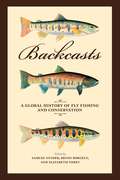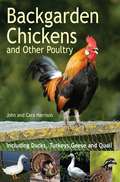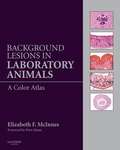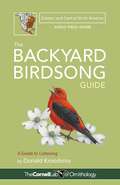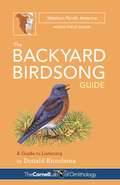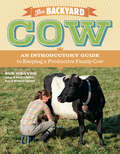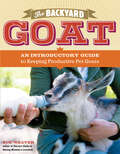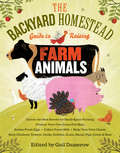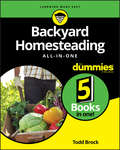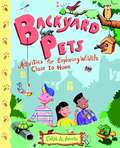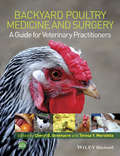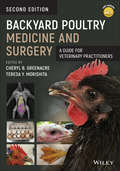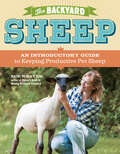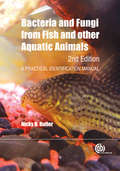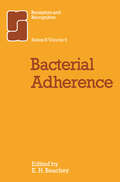- Table View
- List View
Backcasts: A Global History of Fly Fishing and Conservation
by Samuel Snyder, Bryon Borgelt, and Elizabeth Tobey Bryon Borgelt Elizabeth Tobey“Many of us probably would be better fishermen if we did not spend so much time watching and waiting for the world to become perfect.”-Norman Maclean Though Maclean writes of an age-old focus of all anglers—the day’s catch—he may as well be speaking to another, deeper accomplishment of the best fishermen and fisherwomen: the preservation of natural resources. Backcasts celebrates this centuries-old confluence of fly fishing and conservation. However religious, however patiently spiritual the tying and casting of the fly may be, no angler wishes to wade into rivers of industrial runoff or cast into waters devoid of fish or full of invasive species like the Asian carp. So it comes as no surprise that those who fish have long played an active, foundational role in the preservation, management, and restoration of the world’s coldwater fisheries. With sections covering the history of fly fishing; the sport’s global evolution, from the rivers of South Africa to Japan; the journeys of both native and nonnative trout; and the work of conservation organizations such as the Federation of Fly Fishers and Trout Unlimited, Backcasts casts wide. Highlighting the historical significance of outdoor recreation and sports to conservation in a collection important for fly anglers and scholars of fisheries ecology, conservation history, and environmental ethics, Backcasts explores both the problems anglers and their organizations face and how they might serve as models of conservation—in the individual trout streams, watersheds, and landscapes through which these waters flow.
Backcasts: A Global History of Fly Fishing and Conservation
by Samuel Snyder, Bryon Borgelt, and Elizabeth Tobey Bryon Borgelt Elizabeth Tobey“Many of us probably would be better fishermen if we did not spend so much time watching and waiting for the world to become perfect.”-Norman Maclean Though Maclean writes of an age-old focus of all anglers—the day’s catch—he may as well be speaking to another, deeper accomplishment of the best fishermen and fisherwomen: the preservation of natural resources. Backcasts celebrates this centuries-old confluence of fly fishing and conservation. However religious, however patiently spiritual the tying and casting of the fly may be, no angler wishes to wade into rivers of industrial runoff or cast into waters devoid of fish or full of invasive species like the Asian carp. So it comes as no surprise that those who fish have long played an active, foundational role in the preservation, management, and restoration of the world’s coldwater fisheries. With sections covering the history of fly fishing; the sport’s global evolution, from the rivers of South Africa to Japan; the journeys of both native and nonnative trout; and the work of conservation organizations such as the Federation of Fly Fishers and Trout Unlimited, Backcasts casts wide. Highlighting the historical significance of outdoor recreation and sports to conservation in a collection important for fly anglers and scholars of fisheries ecology, conservation history, and environmental ethics, Backcasts explores both the problems anglers and their organizations face and how they might serve as models of conservation—in the individual trout streams, watersheds, and landscapes through which these waters flow.
Backcasts: A Global History of Fly Fishing and Conservation
by Samuel Snyder Bryon Borgelt Elizabeth Tobey James Prosek Chris Wood Jen Corrinne Brown“Many of us probably would be better fishermen if we did not spend so much time watching and waiting for the world to become perfect.”-Norman Maclean Though Maclean writes of an age-old focus of all anglers—the day’s catch—he may as well be speaking to another, deeper accomplishment of the best fishermen and fisherwomen: the preservation of natural resources. Backcasts celebrates this centuries-old confluence of fly fishing and conservation. However religious, however patiently spiritual the tying and casting of the fly may be, no angler wishes to wade into rivers of industrial runoff or cast into waters devoid of fish or full of invasive species like the Asian carp. So it comes as no surprise that those who fish have long played an active, foundational role in the preservation, management, and restoration of the world’s coldwater fisheries. With sections covering the history of fly fishing; the sport’s global evolution, from the rivers of South Africa to Japan; the journeys of both native and nonnative trout; and the work of conservation organizations such as the Federation of Fly Fishers and Trout Unlimited, Backcasts casts wide. Highlighting the historical significance of outdoor recreation and sports to conservation in a collection important for fly anglers and scholars of fisheries ecology, conservation history, and environmental ethics, Backcasts explores both the problems anglers and their organizations face and how they might serve as models of conservation—in the individual trout streams, watersheds, and landscapes through which these waters flow.
Backcasts: A Global History of Fly Fishing and Conservation
“Many of us probably would be better fishermen if we did not spend so much time watching and waiting for the world to become perfect.”-Norman Maclean Though Maclean writes of an age-old focus of all anglers—the day’s catch—he may as well be speaking to another, deeper accomplishment of the best fishermen and fisherwomen: the preservation of natural resources. Backcasts celebrates this centuries-old confluence of fly fishing and conservation. However religious, however patiently spiritual the tying and casting of the fly may be, no angler wishes to wade into rivers of industrial runoff or cast into waters devoid of fish or full of invasive species like the Asian carp. So it comes as no surprise that those who fish have long played an active, foundational role in the preservation, management, and restoration of the world’s coldwater fisheries. With sections covering the history of fly fishing; the sport’s global evolution, from the rivers of South Africa to Japan; the journeys of both native and nonnative trout; and the work of conservation organizations such as the Federation of Fly Fishers and Trout Unlimited, Backcasts casts wide. Highlighting the historical significance of outdoor recreation and sports to conservation in a collection important for fly anglers and scholars of fisheries ecology, conservation history, and environmental ethics, Backcasts explores both the problems anglers and their organizations face and how they might serve as models of conservation—in the individual trout streams, watersheds, and landscapes through which these waters flow.
Backgarden Chickens and Other Poultry
by John HarrisonA practical and indispensable guide which covers all you need to know about keeping poultry in your own back garden.Find out:What housing and basic equipment you need.How to choose and obtain the right poultry for the space you have available.Which are the best breeds of chickens, ducks, turkeys, geese and quail for your circumstances.How to help your poultry settle into their new homes.How to feed and care for your poultry.How to breed your ownHow to store eggs and increase production.And even how to cull your birds.
Background Lesions in Laboratory Animals E-Book: A Color Atlas
by Elizabeth Fiona McInnesBackground Lesions in Laboratory Animals will be an invaluable aid to pathologists needing to recognize background and incidental lesions while examining slides taken from laboratory animals in acute and chronic toxicity studies, or while examining exotic species in a diagnostic laboratory. It gives clear descriptions and illustrations of the majority of background lesions likely to be encountered. Many of the lesions covered are unusual and can be mistaken for treatment-related findings in preclinical toxicity studies. The Atlas has been prepared with contributions from experienced toxicological pathologists who are specialists in each of the laboratory animal species covered and who have published extensively in these areas.over 600 high-definition, top-quality color photographs of background lesions found in rats, mice, dogs, minipigs, non-human primates, hamsters, guinea pigs and rabbits a separate chapter on lesions in the reproductive systems of all laboratory animals written by Dr Dianne Creasy, a world expert on testicular lesions in laboratory animals a chapter on common artifacts that may be observed in histological glass slides extensive references to each lesion described aging lesions encountered in all laboratory animal species, particularly in rats in mice which are used for carcinogenicity studies
The Backyard Birdsong Guide Eastern and Central North America: A Guide to Listening
by Donald Kroodsma Larry McQueen Jon JanosikBack by popular demand with more than 300,000 copies sold, the Cornell Lab of Ornithology is proud to re-release the widely acclaimed and bestselling bird audio field guide series, Backyard Birdsongs, from award-winning Ornithologist and Author, Donald Kroodsma.Backyard Birdsongs is an interactive handbook of birds and their songs for beginning bird-watchers. With a touch-button electronic module housing common vocalizations of 75 species from across Eastern and Central North America, this volume offers a truly sensory way to identify and get to know local birds. Crisply detailed and scientifically accurate illustrations accompany each entry, and up-to-date range maps provide clear geographical reference points. Complete with an introduction to birdsongs that will inspire readers to look out their kitchen windows and venture out in the field, this unique book provides an exciting entryway into the subtle art of birding.This second edition includes a much-requested new Sound Track Index (to help make watching and listening to birds easier), and a download of the award-winning MERLIN™ Bird ID App available FREE on iTunes and Android stores (no code necessary).35% of the net proceeds from the sale of Backyard Birdsongs supports projects at the Cornell Lab, such as children’s educational and community programs.
The Backyard Birdsong Guide Western North America: A Guide to Listening
by Donald Kroodsma Larry McQueen Jon JanosikBack by popular demand with more than 300,000 copies sold, the Cornell Lab of Ornithology is proud to re-release the widely acclaimed and bestselling bird audio field guide series, Backyard Birdsongs, from award-winning Ornithologist and Author, Donald Kroodsma.Backyard Birdsongs is an interactive handbook of birds and their songs for beginning bird-watchers. With a touch-button electronic module housing common vocalizations of 75 species from across Eastern and Central North America, this volume offers a truly sensory way to identify and get to know local birds. Crisply detailed and scientifically accurate illustrations accompany each entry, and up-to-date range maps provide clear geographical reference points. Complete with an introduction to birdsongs that will inspire readers to look out their kitchen windows and venture out in the field, this unique book provides an exciting entryway into the subtle art of birding.This second edition includes a much-requested new Sound Track Index (to help make watching and listening to birds easier), and a download of the award-winning MERLIN™ Bird ID App available FREE on iTunes and Android stores (no code necessary).35% of the net proceeds from the sale of Backyard Birdsongs supports projects at the Cornell Lab, such as children’s educational and community programs.
The Backyard Cow: An Introductory Guide to Keeping a Productive Family Cow
by Sue WeaverA friendly, accessible guide to every aspect of raising, keeping, caring for, and enjoying a family cow, with a focus on providing milk and other dairy products.
The Backyard Goat: An Introductory Guide to Keeping and Enjoying Pet Goats, from Feeding and Housing to Making Your Own Cheese
by Sue WeaverA beginner&’s guide for those who want to keep goats as pets or to produce milk, cheese, and fiber.
The Backyard Homestead Guide to Raising Farm Animals: Choose the Best Breeds for Small-Space Farming, Produce Your Own Grass-Fed Meat, Gather Fresh Eggs, Collect Fresh Milk, Make Your Own Cheese, Keep Chickens, Turkeys, Ducks, Rabbits, Goats, Sheep, Pigs, Cattle, & Bees (Backyard Homestead)
by Richard E. Bonney Gail Damerow Kelly Klober Darrell L. Salsbury Malcolm T. Sanford Nancy Searle Paula Simmons Heather Smith ThomasEnjoy a weekend breakfast featuring eggs, bacon, and honey from your own chickens, pigs, and bees, or a holiday meal with your own heritage-breed turkey as the main attraction. Gail Damerow covers everything you need to successfully raise your own farm animals, from selecting the right breeds to producing delicious fresh milk, cheese, honey, eggs, and meat. Even with just a small plot of land, you can become more self-sufficient, save money, and enjoy healthy, delicious animal products. Also available in this series: The Backyard Homestead, The Backyard Homestead Book of Building Projects, The Backyard Homestead Seasonal Planner, and The Backyard Homestead Book of Kitchen Know-How.
Backyard Homesteading All-in-One For Dummies
by Todd BrockLive a more sustainable lifestyle Historically referred to as a government program for revitalizing undesirable living areas, "homesteading" today has come to mean the pursuit of a self-sufficient lifestyle. Homesteading can include everything from keeping bees, growing vegetables, and composting to installing solar panels, creating a rain barrel, and canning your own food,—plus much more. Backyard Homesteading All-in-One For Dummies has a little bit of everything for the homesteader in all of us. It walks you through the basics of creating your own sustainable homestead and offers expert tips and tricks for making it as easy and successful as possible. Raise chickens Keep bees Compost Can and preserve This book gives you everything you need to embark on your own homesteading adventure.
Backyard Homesteading All-in-One For Dummies
by Todd BrockLive a more sustainable lifestyle Historically referred to as a government program for revitalizing undesirable living areas, "homesteading" today has come to mean the pursuit of a self-sufficient lifestyle. Homesteading can include everything from keeping bees, growing vegetables, and composting to installing solar panels, creating a rain barrel, and canning your own food,—plus much more. Backyard Homesteading All-in-One For Dummies has a little bit of everything for the homesteader in all of us. It walks you through the basics of creating your own sustainable homestead and offers expert tips and tricks for making it as easy and successful as possible. Raise chickens Keep bees Compost Can and preserve This book gives you everything you need to embark on your own homesteading adventure.
Backyard Pets: Activities for Exploring Wildlife Close to Home
by Carol A. AmatoGet to know the amazing creatures right outside your door! What do toads like to eat? Why do crickets sing? Why does a firefly glow? If you've ever longed to know more about the habits of the animals and insects that live in your backyard, here's the book you've been waiting for! With Backyard Pets, you'll find out how to catch and care for lots of different, easy-to-find critters, from terrific toads to slithering slugs. You'll perform all sorts of investigations and activities, including discovering how snails eat and how caterpillars protect themselves, before you return your newly found pets safely to their natural home. And you'll even find out how to attract birds and butterflies to homemade feeders and gardens so that you can observe them every day as they go about their amazing lives. As you take care of your pets, you'll learn how to interpret fireflies' signals; how to entice worms from their burrows with sound; and how to make birdfeeders, hummingbird gardens, and toad abodes. Along the way, you'll discover lots of fascinating facts about the lives of these clever critters-from what their favorite foods are to how they see, hear, and move, and even how they help the environment.
Backyard Poultry Medicine and Surgery: A Guide for Veterinary Practitioners
by Cheryl B Greenacre Teresa Y MorishitaBackyard Poultry Medicine and Surgery is a practical resource offering guidance on developing diagnostic and treatment plans for individual companion poultry or small flocks. Organized by body system to aid in developing a differential diagnosis list for common presenting signs, the book provides all the information clinicians need to effectively treat backyard poultry. Written by experts from both the commercial poultry field and the companion avian field, the book provides thorough coverage of both common and less common diseases of backyard chickens, ducks, and other poultry. The book begins with introductory chapters covering general information, an overview of US laws, and basic husbandry concerns, then moves into specific disease chapters organized by system. The book takes an individual medicine perspective throughout, with photographs, radiographs, and histopathological photomicrographs to illustrate principles and diseases. Backyard Poultry Medicine and Surgery is an invaluable guide to diseases and treatments for any practitioners treating backyard poultry.
Backyard Poultry Medicine and Surgery: A Guide for Veterinary Practitioners
by Cheryl B. Greenacre Teresa Y. MorishitaBackyard Poultry Medicine and Surgery is a practical resource offering guidance on developing diagnostic and treatment plans for individual companion poultry or small flocks. Organized by body system to aid in developing a differential diagnosis list for common presenting signs, the book provides all the information clinicians need to effectively treat backyard poultry. Written by experts from both the commercial poultry field and the companion avian field, the book provides thorough coverage of both common and less common diseases of backyard chickens, ducks, and other poultry. The book begins with introductory chapters covering general information, an overview of US laws, and basic husbandry concerns, then moves into specific disease chapters organized by system. The book takes an individual medicine perspective throughout, with photographs, radiographs, and histopathological photomicrographs to illustrate principles and diseases. Backyard Poultry Medicine and Surgery is an invaluable guide to diseases and treatments for any practitioners treating backyard poultry.
Backyard Poultry Medicine and Surgery: A Guide for Veterinary Practitioners
by Cheryl B. Greenacre Teresa Y. MorishitaBackyard Poultry Medicine and Surgery, Second Edition is a thorough revision and expansion of the first book to provide practical information for veterinarians treating individual or small flocks of poultry. With seven new chapters covering toxicology, euthanasia, gross pathology, behavior, game bird medicine, vaccinations, and drugs, and many existing chapters significantly expanded, the book offers a complete guide to all aspects of husbandry, medicine, and surgery for backyard poultry. Organized by organ system for ease of use, the book is designed to support veterinarians in diagnosing and treating backyard chickens, whether they see an occasional bird or regularly treat poultry. More than 400 color photographs aid in breed identification and diagnosis, and the clinical focus enables veterinarians to confidently and knowledgably develop a diagnostic and treatment plan. Chapters are written by leading experts in avian medicine and surgery. Backyard Poultry Medicine and Surgery is a must-have reference for any veterinarian called on to care for backyard flocks, whether they see an occasional chicken or treat poultry regularly. Offers a comprehensive guide to diagnosing and treating backyard poultry Presents practical information on husbandry, medicine, and surgery Written from an individual medicine perspective to aid practitioners in developing a diagnostic and treatment plan for the individual or small flock of poultry Expands significantly on the first edition, with many expanded chapters and seven brand-new chapters Includes new chapters covering toxicology, euthanasia, gross pathology, behavior, game bird medicine, vaccinations, and drugs Provides more color photographs to aid in breed and disease identification
Backyard Poultry Medicine and Surgery: A Guide for Veterinary Practitioners
by Cheryl B. Greenacre Teresa Y. MorishitaBACKYARD POULTRY MEDICINE AND SURGERY An expanded edition that explains the diagnosis and treatment of backyard poultryYou can look to Backyard Poultry Medicine and Surgery, Second Edition for practical veterinary information on the treatment of poultry. You’ll find six new chapters covering radiology, toxicology, euthanasia, gross pathology, behavior, and emergency medicine. The book is written by some of the most respected specialists in a broad range of fields.With many original chapters also significantly expanded, the book provides a complete guide to all aspects of husbandry, medicine, and surgery for poultry. Diseases are organized by body systems to aid in developing a diagnosis. This book supports your work as a practitioner, whether you treat birds occasionally or regularly.Review information on the topics of husbandry, medicine, and surgeryGain guidance on developing a diagnostic or treatment plan for the individual or small flock of poultryChoose appropriate doses of labeled and extra-label drugsFind new chapters on emergency medicine, toxicology, euthanasia, gross pathology, normal and abnormal radiographic findings, and other key topicsUse color photographs to aid in breed identification and poultry disease diagnosesView photographs, videos, and linked references and websites on an accompanying websiteThis is an essential and comprehensive guide providing enhanced and updated information to support all types of practitioners—from the dedicated avian veterinarian to those who rarely treat these species.
The Backyard Sheep: An Introductory Guide to Keeping Productive Pet Sheep
by Sue WeaverRaise a flock of sheep in your backyard. Even with a limited amount of space, you can enjoy homegrown fleece and fresh milk, as well as the endearing company of these family-friendly animals. Sue Weaver provides all the instructions you need for selecting a breed; housing and feeding; harvesting fleece; and milking. With simple recipes for making cheese and yogurt, and tips on processing fleece for wool, you&’ll enjoy the varied and numerous rewards of keeping sheep.
Bacteria and Fungi from Fish and Other Aquatic Animals: A Practical Identification Manual
by Nicky BullerThis practical book provides an updated resource for the identification of bacteria found in animals inhabiting the aquatic environment, illustrated with colour photos. It contains expanded biochemical identification tables to include newly identified pathogenic and saprophytic bacteria, molecular identification tests now available for a greater number of aquatic bacterial pathogens, more information on the pathogenesis and virulence of each organism and new coverage of traditional and molecular identification of fungal pathogens and quality assurance standards for laboratories.
Bacteria in Nature: Volume 3: Structure, Physiology, and Genetic Adaptability (Bacteria in Nature #3)
by Edward R. Leadbetter Jeanne S. PoindexterThe value of studies of monotypic populations is constantly argued in bacterial ecology. The controversy itself is evidenceofthe strong awareness that bacterial activities in natural sites are not determined by the bacteria alone. At the same time, the best evidence that bacteria are influenced by environmental factors is the contrast between their behavior in laboratory cultures and their relatively subdued influence when in the presence of com petitors, predators, and fluctuating-often stressful-environmental conditions. Monotypic populations are admittedly reductionist, but are not therefore irrelevant to bacterial ecology. Quite the contrary. Without pure culture studies, our understanding of important and applicable bacterial activities-N fixation, for example-would still be z limited to what we could discern from a comparison of events in steamed vis-a-vis un heated soil. As was evident throughout the previous volume in this treatise, practically any method of studying natural bacterial communities upsets them while permitting only limited assessment of the respective qualities and quantitative contributions to total com munity activity of each type of bacterium present. Total activity itself is difficult to assess and is not dependably accomplished by any single method. This third volume comprises information regarding the properties of bacteria as they have been learned largely from pure culture studies. Its purpose is twofold: to provide readers with fundamental information regarding the cellular organization, physiological capabilities, and genetic systems of bacteria; and to connect known bacterial properties with environmental influences on them and with their influences on natural processes.
Bacteria in Nature: Volume 1: Bacterial Activities in Perspective (Bacteria in Nature #1)
by Edward R. Leadbetter Jeanne S. PoindexterAny branch of biology depends for its progress on the development of new concepts and to a lesser, but sometimes crucial, extent on the elimination of erroneous notions. Understanding the roles of bacteria required first the observation that such minute creatures existed, and subsequently the exper imental demonstrations that their presence was necessary for the occurrence of particular phenomena. In this first volume, the authors review the development of scientific understanding of the role of microbes as agents of diverse natural processes. Notably absent is a separate review of the history of microbes as agents of disease, a his tory available in many other publications. Regrettably absent is a review of the his tory of microbes as agents of inorganic transformations, a serious omission that resulted from the illness of the prospective author late in the preparation of this volume. The topic will of course be treated in later volumes, although not predominantly in a historical manner. Otherwise, the emphasis in this volume is on the history of understanding interrelationships between modes of bacterial existence and the inanimate environment. These relationships were established long be fore multicellular, differentiated or ganisms appeared as potential microbial habitats, and their recognition and elucidation contributed greatly to the widened appreciation of bacterial di versity and the importance of these simpler creatures to the physiochemical conditions of the biosphere.
Bacterial Adherence (Receptors and Recognition #6)
by C. BeacheyBacteria adhere to and colonize almost any surface. Within minutes after sub merging a solid object in seawater or freshwater, the surface becomes colonized by adherent micro-organisms, and the earliest organisms to adhere are bacteria. Adherent colonies of bacteria have also been observed on particles of sand, soil, other bacteria, plant tissues, and a variety of animal tissues. Shortly after birth, the skin and the mucosal surfaces of the upper respiratory tract and the gastro intestinal tract of animals and man become heavily colonized by a variety of adherent bacteria which persist in varying numbers as indigenous parasites. The apparent symbiotic balance between the host and his indigenous parasites oc casionally is upset by the invasion of harmful bacteria which adhere to and colonize these surfaces. Pathogenic bacteria may also adhere to and colonize normally sterile surfaces such as the mucosa of the genito-urinary tract and the lower respiratory tract, and occasionally even endothelial surfaces of the cardiovascular system, resulting in the development of serious infectious diseases. Although marine microbiologists have been aware for a long time that bacteria must stick to surfaces in order to avoid being swept away by moving streams of water, not until recently has it been widely recognized that adherence must be an important ecological determinant in the colonization of specific sites in plants and animals, and in particular an important early event in the pathogenesis of bacterial infections in animals and man. It is true that Dr G.
Bacterial Adhesion: Mechanisms and Physiological Significance
by M. Fletcher D. C. SavageStudy of the phenomena of bacterial adhesion to surfaces has accelerated considerably over the past 10 to 15 years. During this period, microbiologists have become increasingly aware that attachment to a substratum influences considerably the activities and structures of microbial cells. Moreover, in many cases attached communities of cells have important effects on their substratum and the surrounding environment. Such phenomena are now known to be important in plant and animal hosts, water and soil ecosystems, and man-made structures and industrial processes. Much work on microbial adhesion in the early 1970s was descriptive. Those studies were important for detecting and describing the phenomena of bacterial adhesion to substrata in various environments; the findings have been presented in numerous recently published, excellent books and reviews. In some studies, attempts were made to elucidate some funda mental principles controlling adhesion processes in different environments containing a variety of microorganisms. Common threads have been observed occasionally in different studies. Taken as a whole, however, the information has revealed that many disparate factors are involved in adhesion processes. Whether a particular microorganism can adhere to a certain substratum depends on the properties of the microbial strain itself and on charac teristics of the substratum and of the environment.
Bacterial Adhesion to Cells and Tissues
by Itzhak Ofek Ronald J. DoyleAttachment to host cells or tissues is often the first step in the establishment of bacterial infections. A complex array of recognition, attachment, and virulence factors is involved in this process, which recent research has greatly illuminated. This comprehensive and authoritative volume discusses the specific cell and tissue-specific affinities of pathogenic microorganisms, including bioinorganic surfaces such as teeth, and is an essential reference for researchers and students of host-pathogen interactions.
